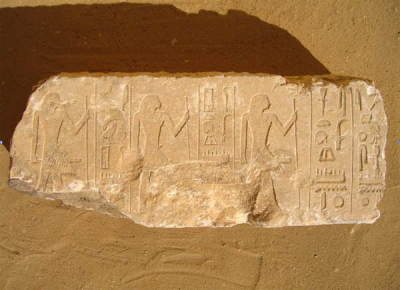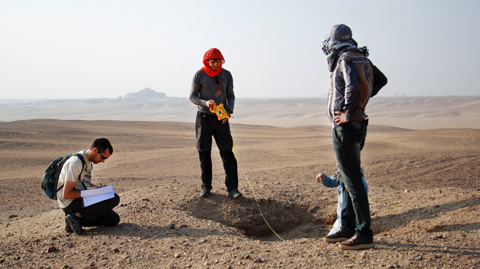
The ICAC participates in an archaeological intervention in the site of Kom el-Khamaseen (Saqqara, Egypt), in relation to the research project Spanish-Egyptian Mission in South-West Saqqara. The Site of Kom el-Khamaseen and Surrounding Area, led by Dr Josep Cervelló Autuori, director and researcher at IEPOA, Institute of Studies of Ancient Near East (Autonomous University of Barcelona).
Josep Maria Puche, from the Graphic Documentation Unit at the ICAC, is these days in the archaeological site (from June 24 to 30), in charge of the project’s topography and planimetry.
The Saqqara Desert, where there is the famous step pyramid of Pharaoh Djoser, is one of the most emblematic areas of Egypt and contains the main necropolis of the city of Memphis, on the west side of the Nile, located about 30 km from Cairo and 17 km from Giza.
The new campaign has reported in the area new unreleased archaeological sites, next to a site that was already plundered in 1999. Precisely due to repeated looting in the area, an urgent archaeological intervention at the necropolis of Kom el-Khamaseen and the adjacent area was considered necessary.
The project is a UAB initiative, with the participation of Egyptologists and archaeologists from the Department of Antiquity and Middle Age Studies, among them Josep Cervelló (project leader) and Marc Orriols. Besides the ICAC (with Josep Maria Puche), there also an Egyptian research team led by the Egyptologist Mohamed Youssef, and the researcher Zulema Barahona from the University of Basel (Switzerland).

The team from the UAB Institute for Ancient Near Eastern Studies, IEPOA, had already conducted an archaeological survey at the Kom el-Khamaseen site in 1997. This is when it observed that the remains discovered, mainly limestone blocks and granite blocks corresponding to already looted tombs, suggested that it was the site of a small necropolis from the end of the Old Kingdom.
Although in 1999 the site was violently plundered and therefore no further work could be conducted at that moment, in posterior campaigns researchers studied the hieroglyphics engraved on the blocks left behind by looters and confirmed that the pieces belonged to the tombs of individuals from different social classes. Among them was Imephor, a great priest of the god Ptah in Memphis, capital of Egypt at that time. Since 2009 up until today, up to 30 pieces from the looting of 1999 have been found in art galleries, many of which were then confiscated and sent back to Egypt.
Given that the site has been plundered on several occasions, the current mission is considered a “rescue campaign”, with urgent interventions. There will be a second campaign in 2020.
El IEPOA en Saqqara y Kom el-Khamasín, UAB
Arqueólogos españoles documentan yacimientos inéditos en Saqqara, La Vanguardia
The UAB conducts and archaeological rescue campaign in Saqqara, UAB





